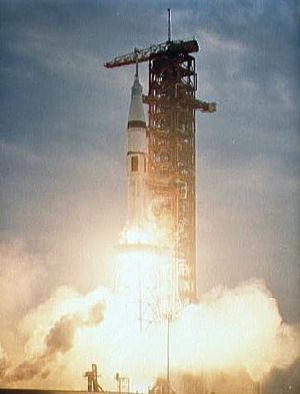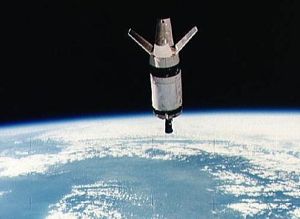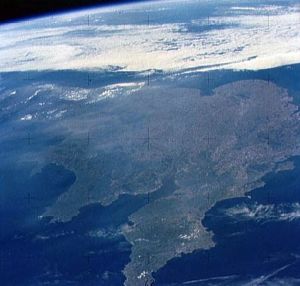
Home - Search - Browse - Alphabetic Index: 0- 1- 2- 3- 4- 5- 6- 7- 8- 9
A- B- C- D- E- F- G- H- I- J- K- L- M- N- O- P- Q- R- S- T- U- V- W- X- Y- Z
Skylab 3

Saturn 1B LC39
Credit: NASA
AKA: Skylab. Launched: 1973-07-28. Returned: 1973-09-25. Number crew: 3 . Duration: 59.46 days. Location: NASA Lewis Research Center, Cleveland, OH.
Continued maintenance of the Skylab space station and extensive scientific and medical experiments. Completed 858 Earth orbits and 1,081 hours of solar and Earth experiments; three EVAs totaled 13 hours, 43 minutes.
The space vehicle, consisting of a modified Apollo command and service module payload on a Saturn IB launch vehicle, was inserted into a 231.3 by 154.7 km orbit. Rendezvous maneuvers were performed during the first five orbits as planned. During the rendezvous, the CSM reaction control system forward firing engine oxidizer valve leaked. The quad was isolated. Station-keeping with the Saturn Workshop began approximately 8 hours after liftoff, with docking being performed about 30 minutes later.
Skylab-3 MANHOUR UTILIZATION
MEDICAL ACTIVITIES 312.5 " 8.0 "
SOLAR OBSERVATIONS 305.1 " 7.8 "
EARTH RESOURCES 223.5 " 5.7 "
OTHER EXPERIMENTS 243.6 " 6.2 "
SLEEP, REST & OFF
DUTY 1224.5 " 31.2 "
PRE/POST SLEEP &
EATING 975.7 " 24.8 "
HOUSEKEEPING 158.4 " 4.0 "
PHYSICAL TRAINING
& PERSONAL HYGIENE 202.2 " 5.2 "
OTHER (EVA) ETC 279.7 " 7.1 "
TOTAL: 3925.2 " 100 "
More at: Skylab 3.
Family: Manned spaceflight. People: Bean, Garriott, Lousma. Country: USA. Spacecraft: Apollo CSM. Launch Sites: Cape Canaveral. Agency: NASA Houston.
 | Skylab 3 Launch of Skylab 3/Saturn 1B space vehicle Credit: NASA |
 | Skylab 3 View of the expended S-IVB second stage of Skylab 3 space vehicle Credit: NASA |
 | Skylab 3 View of the Skylab space station cluster photographed against black sky Credit: NASA |
 | Skylab 3 View of the Skylab space station cluster photographed against black sky Credit: NASA |
 | Skylab 3 View of the Skylab space station cluster photographed against black sky Credit: NASA |
 | Skylab 3 Astronaut Jack Lousma participates in EVA to deploy twin pole solar shield Credit: NASA |
 | Skylab 3 Astronaut Owen Garriott participates in EVA to deploy twin pole solar shield Credit: NASA |
 | Skylab 3 View of Astronaut Owen Garriott in sleep restraints Credit: NASA |
 | Skylab 3 Astronaut Alan Bean flies the Astronaut Manoeuvring Equipment Credit: NASA |
 | Skylab 3 View of Arabella, one of two Skylab spiders and her web Credit: NASA |
 | Skylab 3 Astronaut Jack Lousma participates in EVA to deploy twin pole solar shield Credit: NASA |
 | Skylab 3 Astronaut Owen Garriott participates in EVA to deploy twin pole solar shield Credit: NASA |
 | Skylab 3 Skylab Astronaut participates in EVA to deploy twin pole solar shield Credit: NASA |
 | Skylab 3 Dummy left behind by Skylab 3 crew for the Skylab 4 crew Credit: NASA |
 | Skylab 3 Snow covered Alps of France, Italy, and Switzerland Credit: NASA |
 | Skylab 3 View of a portion of Great Britain looking north-eastward Credit: NASA |
 | Skylab 3 Border area of Turkey-Iran Union of Soviet Socialist Republic Credit: NASA |
 | Skylab 3 Hurricane Ellen over the Atlantic Ocean taken by Skylab 3 crewmen Credit: NASA |
1973 June 11 - July 28 - . LV Family: Saturn I. Launch Vehicle: Saturn IB.
- Skylab 3 space vehicle was moved to pad. - .
Nation: USA.
Program: Skylab.
Flight: Skylab 3.
The Skylab 3 space vehicle was moved to KSC Launch Complex 39, Pad B, on 11 June in preparation for launch. The space vehicle consisted of a Saturn IB launch vehicle S-IB-207 first stage, S-IVB-207 second stage, and a S-IU-208 instrument unit; a CSM; and a spacecraft lunar module adapter. Additional Details: here....
1973 July 3 - .
- Launch date of Skylab 3 set. - . Nation: USA. Program: Skylab. Flight: Skylab 3. Spacecraft: Skylab. The launch date for Skylab 3 was officially established as 28 July 1973. . Additional Details: here....
1973 July 12 - .
- Joint Skylab 3 flight readiness reviews. - . Nation: USA. Program: Skylab. Flight: Skylab 3. Joint Skylab 3 flight readiness reviews and thermal shield design certification reviews were held at KSC. A comprehensive series of center reviews were completed before, and in preparation for, the flight readiness reviews..
1973 July 25 - .
- Planning meetings for the 59-day Skylab 3 mission. - .
Nation: USA.
Program: Skylab.
Flight: Skylab 3.
Twice-weekly experiment planning meetings were being instituted for the 59-day Skylab 3 mission. The purpose of the meetings was to formulate a balanced set of experiment requirements for each upcoming week based on a consideration of plans for the remainder of the mission.
1973 July 28 - . 11:10 GMT - . Launch Site: Cape Canaveral. Launch Complex: Cape Canaveral LC39B. Launch Platform: LUT1. LV Family: Saturn I. Launch Vehicle: Saturn IB.
- Skylab 3 - .
Call Sign: Skylab. Crew: Bean,
Garriott,
Lousma.
Backup Crew: Brand,
Lenoir,
Lind.
Payload: Apollo CSM 117. Mass: 20,121 kg (44,359 lb). Nation: USA.
Agency: NASA Houston.
Program: Skylab.
Class: Moon.
Type: Manned lunar spacecraft. Flight: Skylab 3.
Spacecraft: Apollo CSM.
Duration: 59.46 days. Decay Date: 1973-09-25 . USAF Sat Cat: 6757 . COSPAR: 1973-050A. Apogee: 442 km (274 mi). Perigee: 422 km (262 mi). Inclination: 50.00 deg. Period: 93.20 min.
Continued maintenance of the Skylab space station and extensive scientific and medical experiments. Installed twinpole solar shield on EVA; performed major inflight maintenance; doubled record for length of time in space. Completed 858 Earth orbits and 1,081 hours of solar and Earth experiments; three EVAs totalled 13 hours, 43 minutes.
The space vehicle, consisting of a modified Apollo command and service module payload on a Saturn IB launch vehicle, was inserted into a 231.3 by 154.7 km orbit. Rendezvous maneuvers were performed during the first five orbits as planned. During the rendezvous, the CSM reaction control system forward firing engine oxidizer valve leaked. The quad was isolated. Station-keeping with the Saturn Workshop began approximately 8 hours after liftoff, with docking being performed about 30 minutes later.
1973 July 28 - September 25 - .
- Skylab 3 activation activities curtailed. - .
Nation: USA.
Program: Skylab.
Flight: Skylab 3.
Spacecraft: Apollo ATM,
Skylab,
Skylab.
The Skylab 3 crewmen experienced motion sickness during the first three visit days. Consequently, the Orbital Workshop activation and experiment implementation activities were curtailed. By adjusting the crew's diet and maintaining a low workload, the crew was able to complete the adjustment to space flight in five days, after which flight activities returned to normal. On 25 September, the command module was reactivated and the crew performed the final OWS closeout. Following undocking and separation, the command module entered the atmosphere and landed in the Pacific Ocean approximately 300 km southwest of San Diego. Splashdown was at 6:20 p.m. EDT. The recovery ship, U.S.S. New Orleans, retrieved the command module and crew 42 minutes after landing. The total flight time was 1427 hours 9 minutes 4 seconds. Additional Details: here....
1973 August 2 - .
- Skylab 3 RCS problems - .
Nation: USA.
Flight: Skylab 3.
On 2 August the service module reaction control system engines were inhibited, and the isolation valves closed because of another leak. Acceptable control modes and deorbit and entry procedures were defined, consistent with the constraints imposed by the two reaction control system problems.
1973 August 6 - .
- Anomalies during micrometeoroid shield testing. - . Nation: USA. Program: Skylab. Flight: Skylab 3. Spacecraft: Skylab. Anomalies that had occurred during micrometeoroid shield testing were summarized.. Additional Details: here....
1973 August 7 - . 17:30 GMT - .
- EVA Skylab 3-1 - .
Crew: Garriott,
Lousma.
EVA Duration: 0.27 days. Nation: USA.
Related Persons: Garriott,
Lousma.
Program: Skylab.
Class: Manned.
Type: Manned space station. Flight: Skylab 3.
Spacecraft: Skylab.
Installed second sunshade. Replaced solar camera film cartridges. During EVA by crew members of Skylab 3, a twin-boom sunshade, developed by MSFC, was deployed over the parasol of the OWS. A redesigned and refined thermal parasol had been launched with Skylab 3. However, its use would have required jettisoning the parasol deployed by crew members of Skylab 2, with the possibility of creating the same thermal problems that existed on the OWS prior to the parasol deployment. Following erection of the twin-pole sunshade, the cabin temperature stayed at a comfortable 293-297 K (67.7°F-74.9°F).
1973 August 21 - .
- Skylab 3 - Wakeup Song: Girl from Ipanema - . Flight: Skylab 3. "Girl from Ipanema" and"Anchors Aweigh" CAPCOM: Bob Crippen.
1973 August 22 - .
- Skylab 3 - Wakeup Song: The Party's Over - . Flight: Skylab 3. "The Party's Over" by Julie London CAPCOM: Bob Crippen.
1973 August 23 - .
- Skylab 3 - Wakeup Song: Army Air Corps Song - . Flight: Skylab 3. "Army Air Corps Song" CAPCOM: Bob Crippen.
1973 August 24 - .
- Skylab 3 - Wakeup Song: Come Fly With Me - . Flight: Skylab 3. "Come Fly With Me".
1973 August 24 - . 16:24 GMT - .
- EVA Skylab 3-2 - . Crew: Garriott, Lousma. EVA Duration: 0.19 days. Nation: USA. Related Persons: Garriott, Lousma. Program: Skylab. Class: Manned. Type: Manned space station. Flight: Skylab 3. Spacecraft: Skylab. Replaced solar camera film cartridges; installed replacement gyroscopes..
1973 August 25 - .
- Skylab 3 - Wakeup Song: Julie London and Tijuana Brass - . Flight: Skylab 3. "Julie London and Tijuana Brass" CAPCOM: Bob Crippen.
1973 August 27 - .
- Skylab 3 - Wakeup Song: My Skylab Home - . Flight: Skylab 3. "My Skylab Home" written and performed by Chuck Morley of Cocoa Beach, Florida courtesy of Bill Cummings of Titusville radio station WRMF CAPCOM: Karl Henize.
1973 September - .
- Skylab Rescue (cancelled) - .
Crew: Brand,
Lind.
Nation: USA.
Related Persons: Brand,
Lind.
Program: Skylab.
Flight: Skylab 3,
Skylab Rescue.
Spacecraft Bus: Apollo CSM.
Spacecraft: Apollo Rescue CSM.
Influenced by the stranded Skylab crew portrayed in the book and movie 'Marooned', NASA provided a crew rescue capability for the only time in its history. A kit was developed to fit out an Apollo command module with a total of five crew couches. In the event a Skylab crew developed trouble with its Apollo CSM return craft, a rescue CSM would be prepared and launched to rendezvous with the station. It would dock with the spare second side docking port of the Skylab docking module. During Skylab 3, one of the thruster quads of the Apollo service module developed leaks. When the same problem developed with a second quad, the possibility existed that the spacecraft would not be maneuverable. Preparation work began to fit out a rescue CSM, and astronauts Vance Brand and Don Lind began preparations to rescue astronauts Bean, Garriott, and Lousma aboard the station. However the problem was localized, work arounds were developed, and the first space rescue mission was not necessary. The Skylab 3 crew returned successfully in their own Apollo CSM at the end of their 59 day mission.
1973 September 15 - .
- Skylab 3 - Wakeup Song: Paralyzed - . Flight: Skylab 3. "Paralyzed" by Legendary Stardust Cowboy. Sounded like Marine Close Order Drill to Owen Garriott CAPCOM: Bob Crippen.
1973 September 17 - .
- Skylab 3 - Wakeup Song: Come Saturday Morning - . Flight: Skylab 3. "Come Saturday Morning" preceded by Message from Mother Earth (the alter ego of Bob Crippen).
1973 September 18 - .
- Skylab 3 - Wakeup Song: String of Pearls - . Flight: Skylab 3. "String of Pearls" by Glenn Miller Orchestra.
1973 September 18 - .
- Fish and embryo to be returned to JSC by Skylab 3. - . Nation: USA. Program: Skylab. Flight: Skylab 3. Fish and embryo that were part of a Skylab science demonstration would be returned to JSC by Skylab 3, provided that one or more of the fish were still alive at the time of deactivation. . Additional Details: here....
1973 September 19 - .
- Skylab 3 - Wakeup Song: Marine Corps Hymn - . Flight: Skylab 3. "Marine Corps Hymn" played for Jack Lousma. Jack said Mission Control should be standing at attention..
1973 September 21 - .
- The final Earth resources experiment package pass for Skylab 3 ended. - . Nation: USA. Program: Skylab. Flight: Skylab 3. In all, 39 Earth-oriented passes, six solar inertial passes, two Earth-limb surveys, and two lunar calibration sequences were completed. . Additional Details: here....
1973 September 22 - . 11:18 GMT - .
- EVA Skylab 3-3 - . Crew: Bean, Garriott. EVA Duration: 0.11 days. Nation: USA. Related Persons: Bean, Garriott. Program: Skylab. Class: Manned. Type: Manned space station. Flight: Skylab 3. Spacecraft: Skylab. Replaced film cartridges for solar camera..
1973 September 25 - .
- All primary mission objectives for Skylab 3 were accomplished. - . Nation: USA. Program: Skylab. Flight: Skylab 3. Spacecraft: Apollo ATM, Skylab, Skylab. Additional Details: here....
1973 September 25 - .
- Skylab 3 - Wakeup Song: Going Back to Houston - . Flight: Skylab 3. "Going Back to Houston" (probably"Houston" by Dean Martin) CAPCOM: Henry Hartsfield Skylab 4.
1973 September 25 - . 22:19 GMT - .
- Landing of Skylab 3 - . Return Crew: Bean, Garriott, Lousma. Nation: USA. Related Persons: Bean, Garriott, Lousma. Program: Skylab. Flight: Skylab 3. Skylab 3 landed at 22:19 GMT..
1973 October 4 - .
- An ad hoc committee to analyze the vestibular problems which occurred in previous manned space flights. - .
Nation: USA.
Program: Skylab.
Flight: Skylab 3.
An ad hoc committee to analyze the vestibular problems which occurred in previous manned space flights. An ad hoc committee was established to analyze the vestibular problems which occurred in previous manned space flights and to make recommendations concerning prevention and control on future flights. Particular emphasis was placed on the experiences of the Skylab 3 crew. As a result of the committee meeting, it was recommended that the crewmen of SL-4 take anti-motion-sickness medication immediately upon orbital insertion and follow this with periodic doses for the first three days of flight.
1973 October 24 - .
- A review of Skylab 3 medical data and SL-4 mission planning was conducted by the NASA Administrator. - .
Nation: USA.
Program: Skylab.
Flight: Skylab 3.
Among the items covered were a plan for measuring both the pre- and postflight cardiac outputs of the SL-4 crew; elimination of all activities in the deactivation sequence not absolutely required; and a plan for accommodation of the circadian shift necessary for missions of various durations.
Back to top of page
Home - Search - Browse - Alphabetic Index: 0- 1- 2- 3- 4- 5- 6- 7- 8- 9
A- B- C- D- E- F- G- H- I- J- K- L- M- N- O- P- Q- R- S- T- U- V- W- X- Y- Z
© 1997-2019 Mark Wade - Contact
© / Conditions for Use